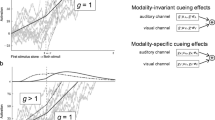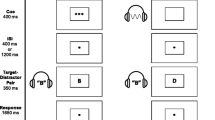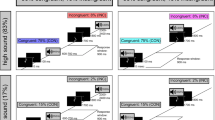Summary
The objective of this study was to analyze the structural properties of the respective inputs that are conducive to immediate auditory-visual cross-modal bias. The study was designed as an updated and extended replication of one by Thomas (1941). Subjects were presented with either auditory or visual target signals in several positions around the median plane, together with a competing signal, always in the other modality, 15° to the left or to the right of that plane. The task was to indicate whether the target signal came left or right of center. Target and competing signals were delivered according to three temporal configurations: continuously on for 4 s, or periodically interrupted at either a fast or a slow tempo, and all combinations of the three configurations were used. Judgements of the location of the auditory target signal were attracted toward the visual competing signal in all conditions but two, those with a periodic target signal and a continuous competing one. Conditions with the two signals in the same configuration yielded larger biases than those combining different configurations, confirming that synchronization of discordant inputs is a major condition of cross-modal interactions. The occurrence of significant bias in nonsynchronous conditions, on the other hand, suggests that another factor might be the attraction of localization responses by competing signals with salient temporal configurations, and that interruption might be one important source of saliency. Auditory biases of visual localization were, as usual, smaller than visual biases, but nevertheless reached significance in a majority of conditions, and were also influenced by timing in much the same way as the latter.
Similar content being viewed by others
References
Bertelson, P., & Radeau, M. (1976). Ventriloquism, sensory interaction and response bias: Remarks on the paper by Choe, Welch, Gilford and Juola. Perception & Psychophysics, 19, 531–535.
Bertelson, P., & Radeau, M. (1981). Cross-modal bias and perceptual fusion with auditory-visual spatial discordance. Perception & Psychophysics, 29, 578–584.
Choe, C. S., Welch, R. B., Gilford, R. M., & Juola, J. F. (1975). The “ventriloquist effect”: Visual dominance or response bias? Perception & Psychophysics, 18, 55–60.
Epstein, W. (1975). Recalibration by pairing: A process of perceptual learning. Perception, 4, 59–72.
Jack, C. E., & Thurlow, W. R. (1973). Effects of degree of visual association and angle of displacement on the “ventriloquism” effect. Perceptual and Motor Skills, 37, 967–979.
Klemm, O. (1909). Lokalisation von Sinneseindrücken bei disparaten Nebenreizen. Psychologische Studien (Wundt), 5, 73–161.
Pick, H. L. Jr, Warren, D. H., & Hay, J. C. (1969). Sensory conflict in judgments of spatial direction. Perception & Psychophysics, 6, 203–205.
Radeau, M., & Bertelson, P. (1976). The effect of a textured visual field on modality dominance in a ventriloquism situation. Perception & Psychophysics, 20, 227–235.
Radeau, M., & Bertelson, P. (1977). Adaption to auditory-visual discordance and ventriloquism in semirealistic situations. Perception & Psychophysics, 22, 137–146.
Radeau, M., & Bertelson, P. (1978). Cognitive factors and adapatation to auditory-visual discordance. Perception & Psychophysics, 23, 341–343.
Thomas, G. J. (1941). Experimental study of the influence of vision on sound localization. Journal of Experimental Psychology, 28, 167–177.
Warren, D. H. (1979). Spatial localization under conflict conditions: Is there a single explanation? Perception, 8, 323–337.
Welch, R. B. (1972). The effect of experienced limb identity upon adaptation to simulated displacement of the visual field. Perception & Psychophysics, 12, 453–456.
Welch, R. B., & Warren, D. H. (1980). Immediate perceptual response to intersensory discrepancy. Psychological Bulletin, 88, 638–667.
Author information
Authors and Affiliations
Additional information
This work was supported in part by the Belgian Fonds de la Recherche Fondamentale Collective (FRFC) under convention 2.4505.80. The first author is Chercheur qualifié of the Fonds National de la Recherche Scientifique (FNRS). The results have already been reported at the Symposium on Perception, Action and Development, Brussels, January 1984
Rights and permissions
About this article
Cite this article
Radeau, M., Bertelson, P. Auditory-visual interaction and the timing of inputs. Psychol. Res 49, 17–22 (1987). https://doi.org/10.1007/BF00309198
Received:
Issue Date:
DOI: https://doi.org/10.1007/BF00309198




